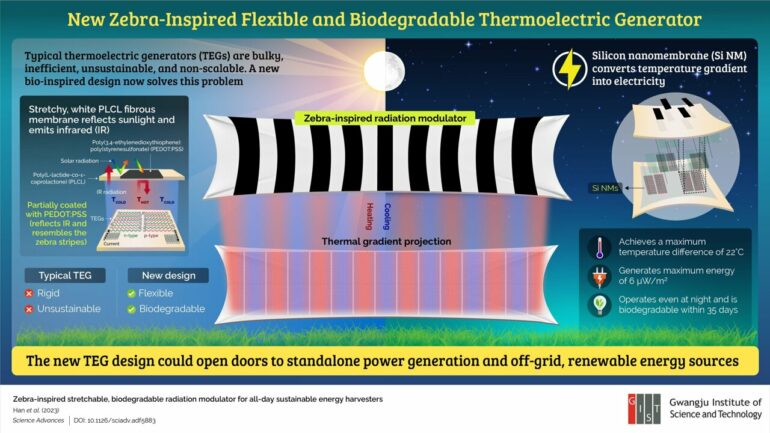Thermoelectric generators (TEG) are devices that can convert temperature gradients to electricity. Such devices are extremely useful for generating electricity for remote sensors that cannot be connected to the main electricity grid. A conventional TEG is composed of one side (top or bottom) that radiates heat to cool down and the other side that absorbs heat from the sun or the environment.
This, in turn, generates an out-of-plane temperature gradient, which is converted into electricity. However, such requirements often make for designs that are bulky, complex, and inefficient. This, in turn, makes TEGs hard to integrate with other components or systems, limiting their applications in renewable energy systems.
Fortunately, researchers from Korea may now have found a way to surmount these challenges. In a new study, the researchers, led by Professor Young Min Song from Gwangju Institute of Science and Technology (GIST), reported a new flexible, lightweight, and biodegradable TEG that gets its inspiration from an unlikely place—zebra skin. Essentially, the design uses a pattern resembling black-and-white zebra stripes to create a high in-plane temperature gradient for generating electricity. The breakthrough was published in Science Advances.
“Traditional TEG designs are large and bulky as they rely on natural convection, which leads to an out-of-plane temperature gradient. This requires hard insulators, which limit the application of TEGs in flexible and wearable devices. We have now transcended this paradigm in our design by creating an in-plane device that is flexible and biodegradable. This increases its applicability while reducing its environmental impact by making it scalable, integrable, and sustainable,” explains Prof. Song.
The researchers used poly(L-lactide-co-ε-caprolactone) (PLCL), a white, flexible, and biodegradable material, for manufacturing the TEG. PLCL reflects sunlight and emits infrared (IR) radiation, which allowed the area below it to be cool. On top of this material, the researchers applied black poly(3,4-ethylenedioxythiophene):poly(styrenesulfonate) or (PEDOT:PSS), which appears black to the eye, bringing out the stripes resembling that on the zebra skin against PLCL.
The reason PEDOT:PSS appears black is that it absorbs the sunlight coming on it while reflecting the IR radiation coming from below it (emitted by the PLCL). This, in turn, increases the temperature of the area below the black stripes, creating alternating warm and cold regions, i.e., a temperature gradient, which can then converted into electricity.
The researchers achieved this conversion using an array of silicon nanomembranes in their design. The novel design was able to generate a maximum temperature difference of 22°C along with a maximum energy density of 6 µW/m². Moreover, the device was completely biodegraded without any remaining by-products with a mere span of 35 days.
With these remarkable properties, the new TEG design is sure to open doors to scalable, eco-friendly energy systems.
“The pandemic caused the widespread use of disposable masks and protective equipment, which pose a huge environmental impact. This underscores the need for sustainable and eco-friendly solutions like TEGs that can incorporated in such wearable devices for performing specialized functions like self-power generation and sensing,” says Prof. Song.
“Our design can fill in this gap thanks to its lightweight and biodegradable nature. It can also be integrated seamlessly into various energy and smart grid technologies to further enhance their functionality and impact,” he concludes.
More information:
Won Bae Han et al, Zebra-inspired stretchable, biodegradable radiation modulator for all-day sustainable energy harvesters, Science Advances (2023). DOI: 10.1126/sciadv.adf5883
Provided by
GIST (Gwangju Institute of Science and Technology)
Citation:
Researchers develop a novel thermoelectric generator inspired by zebra skin (2023, March 9)



